The Battle of Bay Trail-D: GIGABYTE J1900N-D3V and ASUS J1900I-C Reviewed
by Ian Cutress on October 17, 2014 10:00 AM EST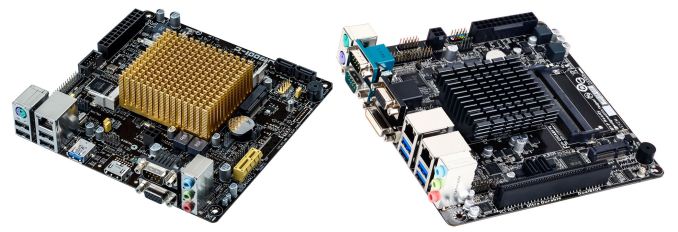
All the recent talk of Haswell-E and high-end refreshes has obscured the more casual computing market. The Bay Trail platform uses Intel’s Atom based Silvermont cores and competes directly against AMD’s Kabini for integrated computing, digital signage and cheap computing models. Today we compare two mini-ITX Celeron J1900 based motherboards: the GIGABYTE J1900N-D3V at $85 and the ASUS J1900I-C at $92, as well as the SoC itself.
Bay Trail-D Overview
Intel’s Atom Silvermont based architecture covers four SoC areas:
- Smartphones, in the form of Merrifield and Moorefield
- Tablets, Notebooks and Embedded in the form of Bay Trail
- Microservers and Storage in the form of Avoton
- Network and Communications in the form of Rangeley
We tested the C2750 eight-core Avoton SoC in the ASRock C2750D4I, a system oriented around maximum DRAM and storage in a mini-ITX form factor, and reported on GIGABYTE’s 46x C2750 Avoton server back at Computex 2014. The microserver market is apparently ripe for Avoton, but Bay Trail makes the desktop and tablet spaces a little more confusing.
Bay Trail comes in four forms:
- Bay Trail-D, for Desktop Systems at 6W to 20W
- Bay Trail-I, for Embedded and Automotive at 5W to 10W
- Bay Trail-M, for Mobile and Netbooks at 4W to 7.5W
- Bay Trail-T, for Tablets and Hybrids at 2W
We have covered Bay Trail in Mobile and Tablets, such as the ASUS Transformer Book T100 that has the Atom Z3740 Bay Trail-T, but the casual desktop space is still an interesting market. ECS’ LIVA is a perfect example of this: Ganesh’s review of the LIVA with the 4.5W Celeron N2806 Bay Trail-M shows that with enough innovation, some interesting designs can be produced.
Today’s review focuses on the Celeron J1900, a quad core 10W Bay Trail-D with Intel Ivy Bridge HD Graphics (6 EUs). The CPU has a base frequency of 2.0 GHz with a 2.42 GHz Turbo mode, 2 MB of L2 cache and support for dual channel DDR3L-1333. The J1900 was one of the targets of AMD’s AM1 Kabini launch earlier in the year, where the two traded blows on functionality:
| AMD Athlon 5350 vs. Intel Celeron J1900 | ||||
| Athlon 5350 | Celeron J1900 | |||
| CPU Architecture | Jaguar | Silvermont | ||
| CPU Cores | 4 | 4 | ||
| CPU Frequency | 2.05 GHz | 2.0 GHz / 2.4 GHz Turbo | ||
| GPU Cores | 128 SPs | 6 EUs | ||
| GPU Frequency | 600 MHz | 688 MHz | ||
| Memory Channels | Single | Dual | ||
| Memory Frequency | 1600 MHz | 1333 MHz | ||
| L2 Cache | 2 MB | 2 MB | ||
| TDP | 25 W | 10 W | ||
| Price | $59 | $82 | ||
AMD’s main power point for Kabini was the upgradable platform, due to Intel’s Bay Trail involving soldered on CPUs. Memory compatibility is traded, with Intel supporting dual channel but at a lower frequency. Price is also a battleground, along with GPU cores, although Intel uses significantly less power (on paper).
Because Bay Trail-D is a BGA processor, this means that the processor and motherboard must be purchased in tandem. There are a number of Bay Trail-D combinations available for purchase:
$200 – Jetway JNF9M-2930 (Celeron N2930, Bay Trail-M)
$150 – Habey MITX-6771 (Celeron J1900, Bay Trail-D)
$118 – ASRock Q1900TM-ITX (J1900)
$99 – ASRock Q1900DC-ITX (J1900)
$85 – GIGABYTE J1900N-D3V (J1900)
$80 – ASUS J1800I-A (Celeron J1800, Bay Trail-D)
$79 – ASUS J1800I-C (J1800)
$76 – ASRock Q1900-ITX (J1900)
$75 – Foxconn D190S (J1900)
$70 – ASRock Q1900M (J1900)
$70 – ASRock Q1900B-ITX (J1900)
$63 – Biostar J1800NP (J1800)
$60 – ASRock D1800M (J1800)
$60 – ASRock D1800B-ITX (J1800)
$60 – ASUS J1800I-C (J1800)
Thus for this review, we chose two of what might be the most popular Bay Trail-D motherboards for home builds: two mini-ITX systems, the GIGABYTE J1900N-D3V and the ASUS J1900I-C. Both of these use the Celeron J1900 processor, whereby the J1900 sits in the middle of Intel’s Bay Trail-D offerings but is the top SKU with the Celeron nomenclature:
| Bay Trail-D Comparison | |||||||
| Cores | CPU Frequency |
TDP | L2 Cache | IGP | IGP Frequency |
Price | |
| Celeron J1750 | 2 | 2410 | 10W | 1 MB | HD (Ivy) | 688 / 750 | |
| Celeron J1800 | 2 | 2410 / 2580 | 10W | 1 MB | HD (Ivy) | 688 / 792 | $72 |
| Celeron J1850 | 4 | 2000 | 10W | 2 MB | HD (Ivy) | 688 / 792 | |
| Celeron J1900 | 4 | 2000 / 2420 | 10W | 2 MB | HD (Ivy) | 688 / 854 | $82 |
| Pentium J2850 | 4 | 2410 | 10W | 2 MB | HD (Ivy) | 688 / 792 | |
| Pentium J2900 | 4 | 2410 / 2670 | 10W | 2 MB | HD (Ivy) | 688 / 896 | $94 |
| C2550 (Avoton) | 4 | 2400 / 2600 | 14W | 2 MB | None | N/A | $86 |
| C2750 (Avoton) | 8 | 2400 / 2600 | 20W | 4 MB | None | N/A | $171 |
Four Silvermont cores at 2 GHz for 10W sounds impressive, especially when I think back a decade to what I had back at university, or the 35W Core 2 Mobile CPU I had in my last laptop. As we found with the C2750, single thread speed should be reasonable and while multithreaded applications can take advantage, it doesn’t replace an i3, but ultimately that is not the intended market. Both the GIGABYTE J1900N-D3V and ASUS J1900I-C are going for that base desktop market, where ‘some memory’ and ‘some storage’ are needed, such as digital signage, a basic HTPC or run-of-the-mill all-access government machines.
It is worth noting that for Bay-Trail D, there are two steppings of the processors:
The new C0 stepping allows Intel Quick Sync to be used, but aside from the change in stepping (B3 to C0) there is no other outward indication which version is going to be used unless you are a customer that deals with Intel directly. Even though our samples in this review were new, both contained the B3 stepping version of the SoC.
Nevertheless, some of the Bay Trail-D SKUs to come with a form of Intel Burst, allowing parts of the SoC to turbo depending on how power is needed:
The Bay Trail Chipset
Similar with AM1, the integration of the IO into the SoC means there is no formal south bridge to distribute the ports and all routing is via the SoC:
Here the System Agent negotiates data between the dual channel DDR3L memory controllers, the Silvermont dual core ‘modules’ and the graphics, supplied as 6 EUs based on the Ivy Bridge video architecture. Because the Bay Trail SoC supports far fewer I/O connections compared to our usual foray into consumer based motherboard/CPU combinations, a mini-ITX is enough to almost fit them all.
The full block diagram for the J1900N-D3V is:
The SoC allows four PCIe 2.0 lanes from the chipset, which the manufacturer can use network connections or other IO controllers for. Here GIGABYTE has used two for Realtek NICs, one for a PCIe to PCI bridge and a mini-PCIe for a WiFi card or similar. The SoC supports two SATA 3 Gbps and a single USB 3.0 port, with this GIGABYTE motherbaord using a Renesas hub on that USB 3.0 to expand the offering to four.
Here is where Bay Trail comes across an issue. The system is designed to be cheap and competing with Kabini, meaning that motherboard manufacturers cannot fill the product up with controllers that cost a lot. It would be interesting if the PCIe lanes were used for additional SATA controllers, allowing for a large storage system, but that ends up being exactly what the C2750D4I is. Also, the decision here on the GIGABYTE to use a PCI slot will be for legacy use, as the latest graphics card available that uses PCI would be a HD 5450 or GT610/430.
Legacy connectors are always a touchy subject. Some motherboard reviews on products with a PS/2 or PCI slot might end up with a comment wondering why they still exist. The answer lies in industry, because upgrading that $1,000 PC is cheaper than upgrading the $5,000,000 bit of 15-year old equipment it is connected to. Bay Trail-D, even though is offered to the public, has a use in these motherboards for industry, so GIGABYTE and ASUS have to cover the bases. There are a few key points to consider in this respect:
- Does it have the right connectors?
- Does it cost a lot?
- Is it easy to set up?
- Is it responsive enough?
- Will it compute as much as is needed in a reasonable time?
The last two points end up being the usual reason for upgrading. For example, back in the lab I worked in several years ago our vintage equipment (an older version of this) ran on Pentium 4 machines but required a legacy slot for the proprietary communication and control card it ran on. In order to upgrade, it had to meet the above criteria. This is why legacy still exists.
Back to the review: we are putting both the GIGABYTE J1900N-D3V and the ASUS J1900I-C through their paces for usability as well as the J1900 SoC for responsiveness. These boards are in the $85-$95 mark, providing a competitive price point against AMD’s Kabini. Motherboards at the cheaper end of the spectrum tend to be worked on by less people, purely because the profit margins are low. Both the motherboards in this review are dealing with the fact that they have to include the SoC on the motherboard at the point of sale. Intel lists the price of the J1900 as $82, meaning that these SoCs are actually sold at a discount or in a discounted-revenue strategy, or the motherboard manufacturers are getting them severely discounted in order to make cents per sale.


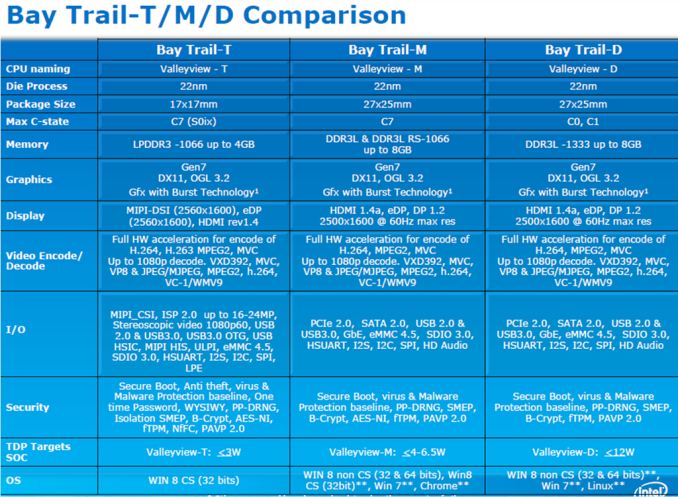
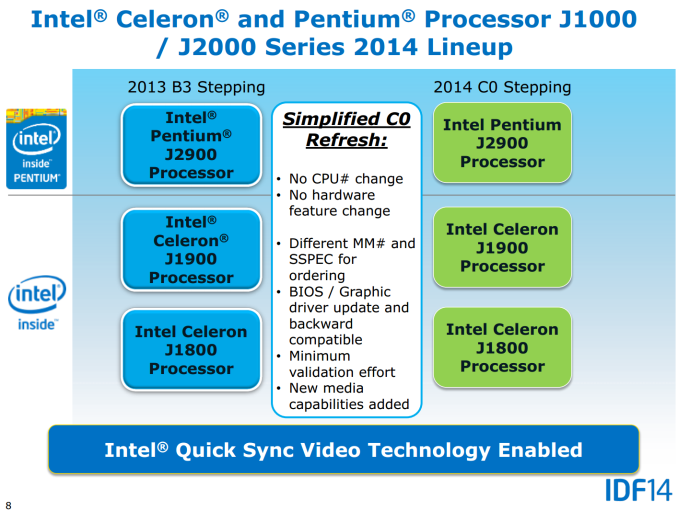
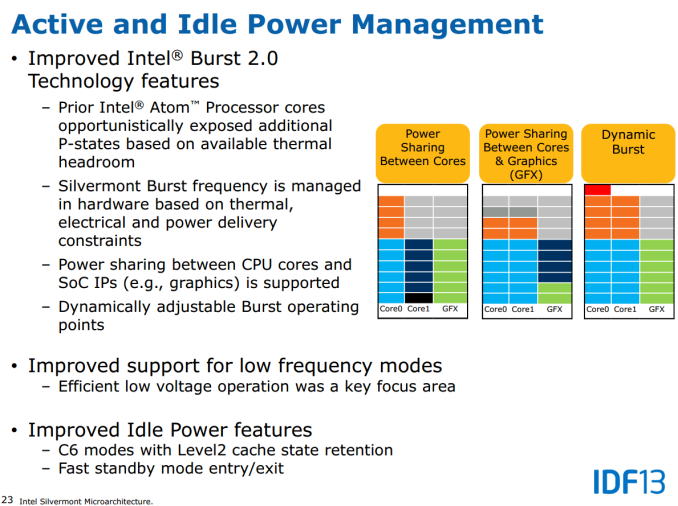
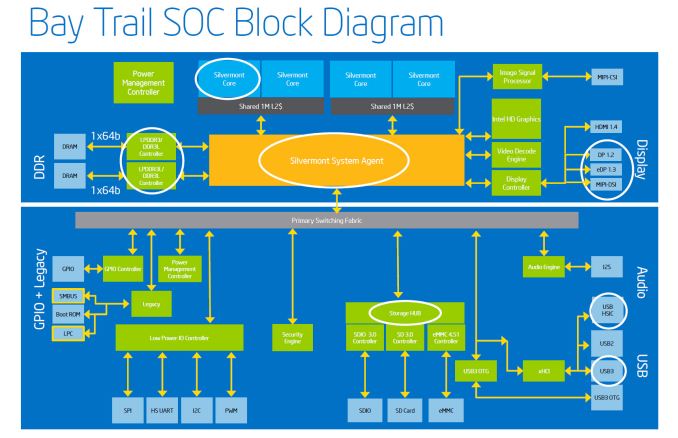
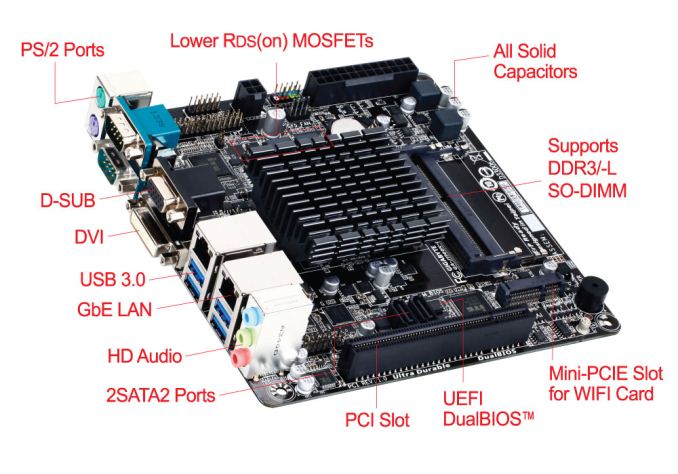
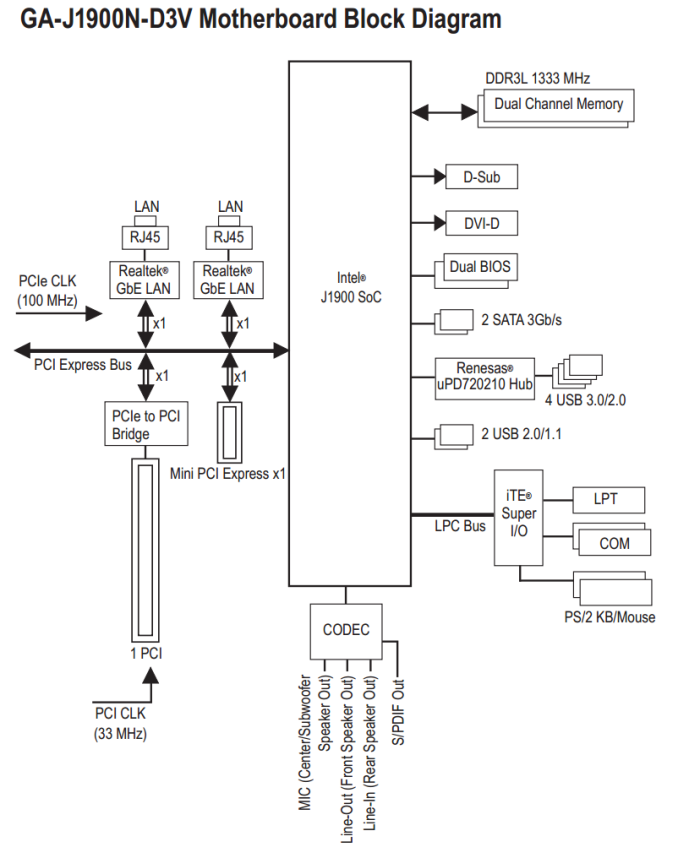








60 Comments
View All Comments
Samus - Friday, October 17, 2014 - link
I have the Foxconn board. It was the only board with a 16x slot (1x electrical) so I wouldn't have to cut the slot or card connector to make it fit a videocard. I run a GT430 in it.I actually tested the GT430 on the previous board (H61, 2nd gen i3-2100) using clear tape to "disconnect" 15 lanes of the PCI-E connector on the card and benchmark the difference between 16x and 1x. No measurable difference.
The GT430 just doesn't have enough compute to saturate the bus even at 1x. Some people have said 3D compute performance takes a hit (something I didn't measure) but this is for an HTPC. I'm sticking with the GT430 because it's still the best low-power passive-cooled HTPC card available.
I just didn't feel the onboard Intel HD video is compelling enough for HTPC use. The customization leaves a lot to be desired and it can't lock 23.976.
Just thought I'd let everyone know this makes an excellent, low-watt HTPC platform as long as you stick with a PCIe videocard. The Asus board can do it (it has clearance behind the 1x PCIe slot for the remaining connector of the card) but you'd have to cut the board connector with an x-acto or dremel, voiding your warranty. Likewise, you can hack off most of the PCIe connector on a cheap video card, too.
Something I want to point out. Power usage of Baytrail is about 5w lower when you don't use the iGPU. The iGPU is completely power-gated when its disabled. This allows the chip to boost more often as well.
I wish this information were in the review, but now you have it.
Mvoigt - Sunday, October 19, 2014 - link
http://www.zotac.com/products/graphics-cards/gefor... slap this in, no need to cut anything...Samus - Monday, October 20, 2014 - link
I thought about a 1x card, and the GT610 has all the bells and whistles of NVidia's drivers (specifically the HTPC customizations)However, the GT430 is the last entry-level passive-cooled card made with a 128-bit bus...although its mostly pointless for HTPC use I think it does make a difference in occasional Bluray accelerated 3D playback.
But the real reason I wanted to stick with the GT430 is I already had one lying around. If I were going to build from scratch, I'd probably consider a 1x card if the price were right. Used Matrox 1x cards can be had on eBay dirt cheap and they are also very customizable in resolution\frequency.
Mvoigt - Tuesday, October 21, 2014 - link
I see your point.... but the geforce GT730 comes in 1X format... and wastly more powerfull than the gt 430Mvoigt - Tuesday, October 21, 2014 - link
No critisismen, but let's hope never cards emerge with 128bit..... i feel what you'r saying.... but quad core low power platform with decent card's with make light gaming possible....Mvoigt - Tuesday, October 21, 2014 - link
They are fucking up the ram though..... 5 years ago i had GTX260 with 448bit ram interface......Mvoigt - Tuesday, October 21, 2014 - link
or 4 years ago, dont remember.....DanNeely - Friday, October 17, 2014 - link
Why do these boards even need a 4pin 12v power connector? Unlike LGA 1150 boards with an x16 PCIe slot, they don't need to worry about a high power CPU and a 75W PCIe card. Legacy PCI runs solely on 3.3v; and x1 cards are limited to 25W. Like p3 and earlier boards they're only drawing at most few amps of 12V; which the big ATX connector is more than capable of providing.wetwareinterface - Sunday, October 19, 2014 - link
the 4 pin is there because you can't rely on the atx connector to provide enough amperage on a small 150-175 watt low profile power supply to give you enough when running a card in the slot. also remember there are 2 pci-e connectors on the asus and a pci-e and pci connector running off a bridge on the gigabyte (effectively making it 2 pci-e slots as far as power is concerned)Samus - Monday, October 20, 2014 - link
I had a previous Atom board that ran without the 4-pin connector...UNTIL you plugged in a PCIe card, then it'd just beep and not post.